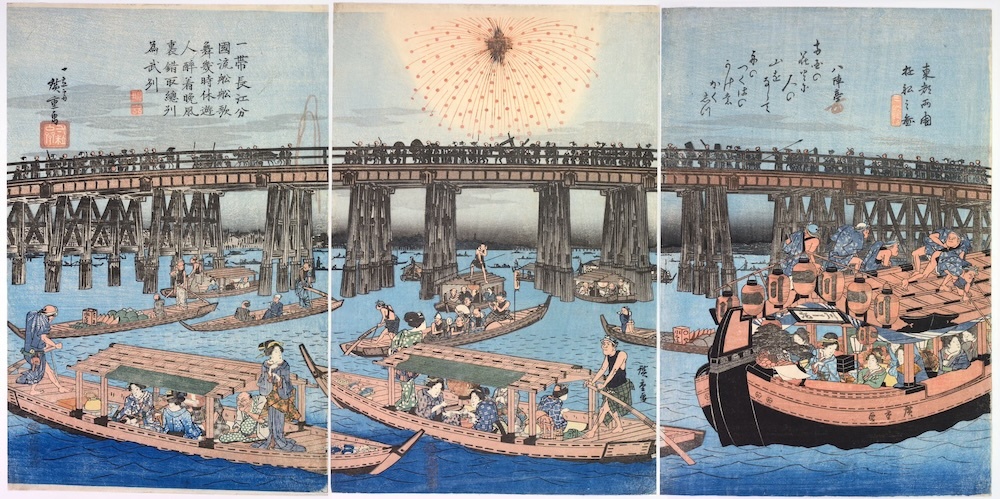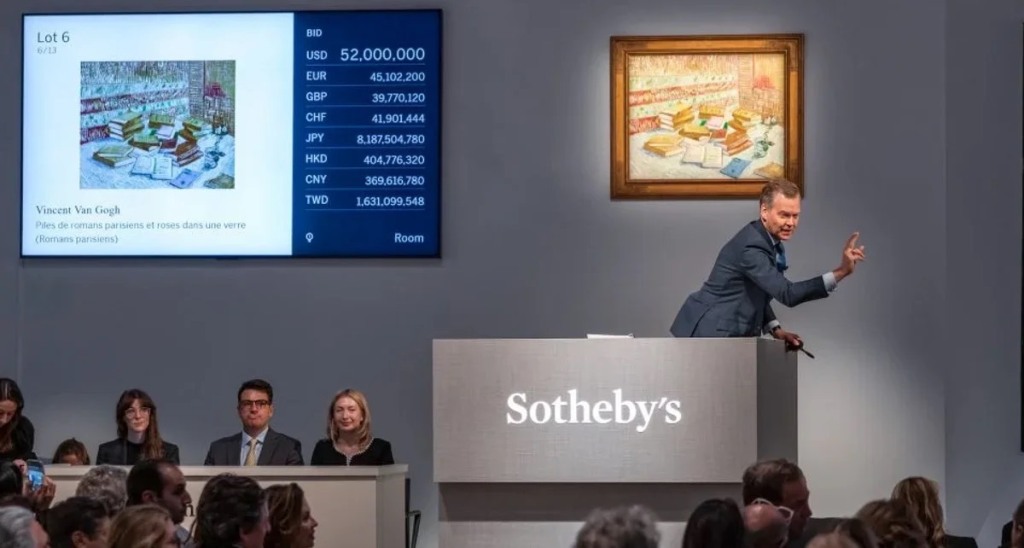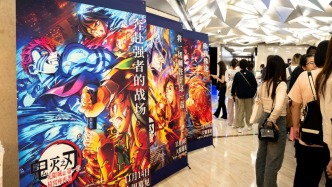
Utagawa Hiroshige was the famous Japanese Ukiyo-e artist whom Van Gogh loved the most and had a great influence on.
The Paper learned that "Utagawa Hiroshige - A Scenic Road" was recently exhibited at the British Museum. This is the first major exhibition of Utagawa Hiroshige held by the British Museum. He painted a picture of a country that is about to undergo tremendous changes, as if he saw nirvana in a touch of Prussian blue.
From fashionable figures and urban landscapes to mountain and water impressions, Hiroshige captured many aspects of Japanese life at the time. His flower and bird paintings show his poetic sensitivity to nature, while his evocative landscapes reflect traces of life in Japan at the time. Hiroshige sometimes depicts the world as it is, and sometimes uses the artist's imagination to present his ideal scenery.

Utagawa Hiroshige, “Ryogoku Cruises in the Touto Region,” color woodblock triptych, 1832–1834. On summer nights during the Edo period (1615–1868), the southern section of the Sumida River was bustling with cruises and fireworks displays. The Ryogoku Bridge, the center of entertainment at the time, runs across the triptych. Floating vendors sell fresh watermelons beneath the bridge, and musicians play music to liven up the atmosphere.
Japanese ukiyo-e artist Utagawa Hiroshige (1797–1858) was born into a low-ranking samurai family in Edo (present-day Tokyo). It was a turbulent period in Japanese history, and as Japan came under pressure from the outside world, Hiroshige’s calm artistic vision resonated with people from all walks of life, offering them comfort and hope.

Utagawa Hiroshige, “Kawahara: Night Snow” from The Fifty-three Stations of the Tokaido, ca. 1832–1833.
At the beginning of his artistic career, Hiroshige, like other Ukiyo-e painters, mainly created "beauty paintings" and portraits of Kabuki actors. It was not until the early 1830s that he turned to the field of landscape painting, which was still a niche field at the time. The "Fifty-three Stations of the Tokaido" series made him famous. From then on, travel became one of the main themes of his works, and he also gave new vitality to the landscape theme.

Exhibition site
The exhibition, which is presented in a circular gallery at the British Museum, features nearly 120 prints and several paintings by Utagawa Hiroshige (including prints, drawings, picture books and paintings from the British Museum’s collection, with special presentations of donations and loans from the important American Hiroshige collector Allen Meadow, as well as loans from other important institutions), fully presenting the breadth of his artistic career. The exhibition emphasizes the collaborative nature of printmaking: Hiroshige works closely with publishers, who are responsible for commissioning and funding each series of works; he also works with highly skilled craftsmen. These craftsmen include engravers who would paste Hiroshige’s original line drawings onto hard and smooth Yamazakura boards and carefully carve them while maintaining the natural rhythm and improvisation of his brushstrokes. The master printer is adept at the "bokashi (gradient smudge)" technique, which is one of the hallmarks of Hiroshige's work.

Utagawa Hiroshige, Cherry Blossoms on the Sumida River, triptych, 1847–1848. A cherry tree spreads its branches under a starry night sky, shrouding three women walking along the Sumida River. The woman on the left is a waitress from the famous restaurant Kokura-an, holding a lantern with the restaurant’s name; she carries food boxes and baskets to pack souvenirs purchased by the two women on the right.
Nonetheless, the uniqueness and power of Hiroshige’s vision remain clear—his landscapes are characterized by a sense of tranquility and cosmic order, sometimes punctuated by humor and a gentle satire of human folly. As well as showcasing Hiroshige’s astonishing artistic achievements, the exhibition considers his global influence—from Japan’s Edo period (1615–1868) to the work of Van Gogh and contemporary artist Julian Opie, among others—but to truly capture the resonance he has evoked would require another major exhibition, rather than just an epilogue.

Utagawa Hiroshige, “The Tare Well” from “Kiso Kaido 69th Street”, circa 1835/1838
In fact, in every corner of the exhibition, it is clear how the French Impressionists accurately inherited the artistic clues of Utagawa Hiroshige. Take "rain" as an example: in Renoir's "Umbrellas", rain becomes a pleasure of urban life, but as early as the 1830s, Hiroshige depicted rain as a pleasant excuse to hold an umbrella in his work "Tarui" (from the "Kiso Kaido 69th" series). His perspective was far ahead of the Impressionists. And the theme of "snow", which was loved by Impressionist painters, was vividly depicted by Hiroshige in "Snow Scene on the Sumida River" between 1832 and 1834, which is fascinating.

Utagawa Hiroshige, "Snow Scene on the Sumida River, a Famous Place in Edo," circa 1832-1834.
This triptych – one of Hiroshige’s favourite modes of expression, splitting a single scene into three separate prints – shows more than just pictorial influence: French avant-garde artists took far more from Hiroshige than visual language. In late 19th-century Paris, artists and writers embraced his philosophy of art almost universally. Snow on the Sumida River embodies Hiroshige’s way of seeing the world, a hedonistic perspective he shared with his subjects. In this work, a family dressed in finery huddles in robes to keep warm in the chill of Edo. But they are not on a difficult winter journey – they are simply enjoying the beautiful wrapping that snow brings to the natural world.
Whether it is a sudden rain, the coolness of the first snow, a meal, or a trip to the theater, Hiroshige's ideal is to enjoy and record the fleeting moments. In his works, happiness lies in savoring these small freedoms. This ideal is also the essence of what early European modernists drew from his work - except that for this devout Buddhist, it was a peaceful and simple common sense, while for those European artists, it was a radical escape route.

Utagawa Hiroshige, “Arashiyama Full of Flowers” from Famous Places of Kyoto, circa 1834
It can be said that this is actually an "exhibition about nothingness." Hiroshige is good at capturing glimpses and weightless moments: a man bids farewell to a female friend at dawn on the Edo flower street, and the blue morning shadows and the gradually pink sky indicate that dawn is coming. In another set of triptychs, two women watch their companions go to the bath, that's all, but you can stare at their expressions, graceful postures, and colorful layers of clothing for an infinite amount of time and be mesmerized by them.

Utagawa Hiroshige, "Falling Wild Goose and Evening Bell" from "Eight Views of Foreign and Domestic Capital", early 1820s
The scenes described by Hiroshige are fresh and vivid, as if they could not only be reproduced in France at the end of the 19th century, but also be re-enacted today. Do you think "pop-up restaurants" are a new idea in the 21st century? In fact, they have existed before. In "The Cooling Off at Shijo River", people gather on a high platform built by the Kamogawa River to enjoy the cool air and eat; in the foreground, a group of men and women sit on a wooden platform where water is still flowing in the river, eating and laughing at their friends' funny dance. This scene seems to be Renoir's "Luncheon on the Boat". As for Manet's "Luncheon on the Grass", it can also be found in the picnic scene depicted by Hiroshige - people spread out cloth towels, sit on the ground, and enjoy the outdoor time.

Utagawa Hiroshige, Cooling off at Shijo River (from the Famous Places of Kyoto series), circa 1834
Hiroshige, however, did not live in the so-called “modern times,” and even the term “modern” may not be appropriate to describe his art. He was born in 1797, when Japan was ruled by the Tokugawa shogunate, a military dictatorship led by the samurai class that almost completely excluded Japan from contact with the world. A set of triptychs he created in the 1830s depicting a procession of samurai is a vivid portrayal of the society at that time, but with a change: this ceremonial procession is composed almost entirely of women—they are escorting a bride to a wedding.

Utagawa Hiroshige, Nihonbashi Bridge—Morning Scene (from the series Fifty-three Stations of the Tokaido), circa 1833–1835. A daimyo (samurai lord)'s procession crosses Nihonbashi Bridge in the early morning light, heading south. Nihonbashi Bridge was the first stop on the Tokaido (East China Sea Coast Road), which connected Edo and Kyoto, and was the starting point for measuring distances throughout Japan. Hiroshige was the son of a firefighter for the shogunate, so he included a fire tower in the background.
Perhaps Geoffrey Chaucer is a more appropriate reference than Baudelaire. In an 1851 painting by Hiroshige, a group of lively pilgrims are making their way to a seaside shrine in Yamanaka, dressed in bright clothes and dancing, their gestures as lively and vivid as Chaucer's pilgrims to Canterbury. What makes this painting so dazzling and moving - indeed, almost all of the works on display - is Hiroshige's ecstatic sense of color. His sea is like a sapphire, the sky is like a flame, the picture is full of dazzling reds and oranges, the kimonos are colorful and contrast with the women's faces - it's a kaleidoscopic visual journey. Hiroshige's scenes of amusement parks, teahouses and picnics seem realistic, but they are full of aura because of his cosmic colors. He seemed to see nirvana in a touch of Prussian blue.

Utagawa Hiroshige, Washing Horses (from The Sixty-ninth Passage of the Kiso Kaido), late 1830s. Villagers follow a gentle river, in harmony with nature. Most of the works in this series depict the path of the Kiso Kaido directly, but Hiroshige only hints at it here through the corner of a roof. He may have intended to show the road in its untouched nature. This painting was largely inspired by the artist's imagination, and was created before he traveled along the road that ran through the mountains between Edo and Kyoto.
The most ardent admirer of Hiroshige in the West was Van Gogh. The exhibition features two versions of the Kameido Plum Shop, one of which Van Gogh copied. In these variations, Hiroshige paints the sky in reddish-pink hues, as if the air were filled with the color of plum juice. The exhibition also shows Van Gogh’s sketches for his paintings, and you can almost feel his intense, focused gaze: he outlines the fruit trees with stiff, fine lines, as if he is trying to draw redemption and joy from Hiroshige’s sweet, intense art.

Utagawa Hiroshige, "One Hundred Scenic Views of Edo: Kameido Umeya-no-Miya", 1857

Utagawa Hiroshige, "Awa: The Storm at Naruto" from "Most Famous Places in Sixty-plus Prefectures", woodcut, color print, 1855
He also experimented with depicting multiple sources of light (a campfire, a lantern, the moon). In some of his nighttime works, in particular, the blank spaces on the paper that remain unpainted suggest lights, or the dramatic lighting in a hotel. Most importantly, his sensitivity to the ephemeral beauty of nature—a plum tree in bloom, a kingfisher skimming across the water—is truly moving, as suggested by the exhibition room’s calming soundscape of gurgling streams, waterfalls, birdsong, and crickets.

Utagawa Hiroshige, Eight Views of Musashi-Kanazawa, Evening Views, triptych, 1857. This triptych (composed of three prints) depicts the Kanazawa area under a full moon, looking out over Edo Bay (present-day Tokyo Bay). Kanazawa is located southwest of Edo. It is speculated that Hiroshige traveled along this coast with three friends in the summer of 1853, sketching the landscape and people along the way. These sketches formed the basis for a handscroll he painted that winter, which eventually became the blueprint for this triptych.
Note: The exhibition will last until September 7.
- uRXbTcJThtJ06/19/2025
- nNzOTsfcJ06/19/2025
- AhUCltrPB06/18/2025
- bAgMXuNmbMj06/18/2025
- akmuugkVTa06/18/2025
- TaCWmdsW06/18/2025

